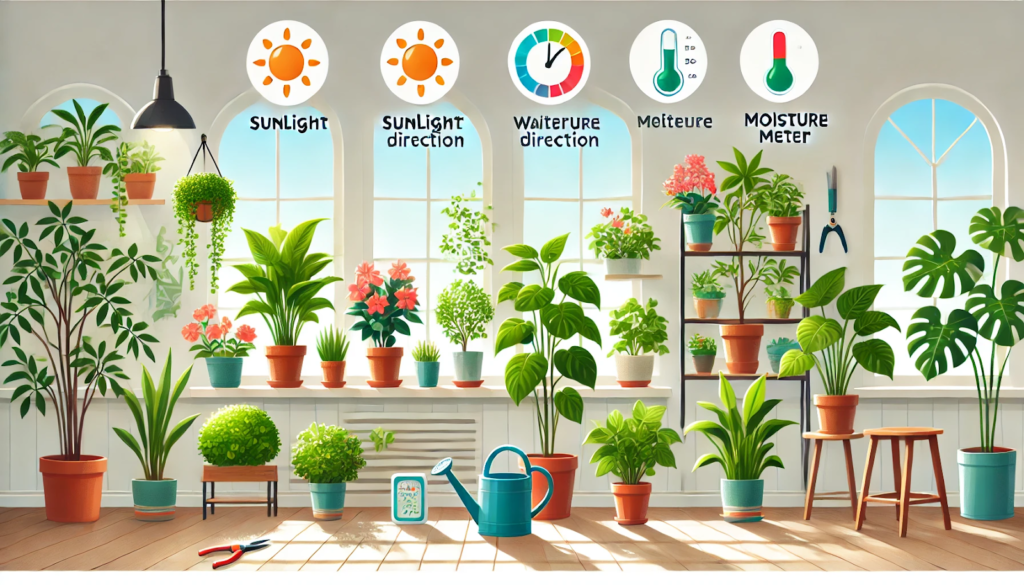Caring for indoor plants may seem simple, but to truly help them thrive, it’s important to understand their specific needs. From proper watering schedules to the right lighting and humidity levels, every factor plays a role in the health and growth of your houseplants. This comprehensive guide covers the key aspects of indoor plant care for beginners and enthusiasts alike.
Understanding Light Requirements
Light is one of the most essential components of plant growth. Indoor plants fall into different categories based on how much light they need.
Types of Light:
- Bright Light (Direct Sunlight): Windows facing south or west.
- Bright Indirect Light: Filtered sunlight, often near sheer curtains.
- Medium Light: A few feet away from a sunny window.
- Low Light: Areas with minimal natural light, such as corners or north-facing windows.
Tips:
- Rotate plants weekly to ensure even growth.
- Avoid placing plants directly against hot glass during peak sun hours.
- Use grow lights if natural light is insufficient, especially in winter months.
Watering Your Indoor Plants
Overwatering is one of the most common causes of houseplant death. Every plant has different needs, and factors like pot size, humidity, and temperature influence watering frequency.
General Guidelines:
- Always check the soil before watering.
- Most plants prefer the top 1–2 inches of soil to dry before rewatering.
- Use pots with drainage holes to prevent root rot.
Watering Methods:
- Top Watering: Slowly pour water into the soil until it drains from the bottom.
- Bottom Watering: Place the pot in a tray of water and let it absorb for 30 minutes.
- Mist Spraying: Best for humidity-loving plants like ferns and calatheas.
Tools:
- Watering can with a long spout
- Moisture meter for checking soil
- Spray bottle for misting
Humidity Control
Many houseplants, especially tropical varieties, thrive in environments with higher humidity.
Ways to Increase Humidity:
- Use a humidifier near your plants.
- Group plants together to create a microclimate.
- Place pots on trays filled with pebbles and water.
- Avoid placing plants near air conditioners or heaters.
Proper Potting and Repotting
Over time, plants outgrow their containers or the soil becomes compacted and less effective.
When to Repot:
- Roots growing through drainage holes
- Water runs straight through the pot without soaking in
- Slow or stunted growth
Repotting Tips:
- Choose a new pot 1–2 inches larger in diameter.
- Use fresh, appropriate soil mix (e.g., cactus mix for succulents).
- Gently loosen roots before replanting and water thoroughly after.
Fertilizing Indoor Plants
Indoor plants need nutrients to support leaf, stem, and root development. Fertilizing helps replenish nutrients lost over time.
Fertilizer Types:
- Liquid Fertilizer: Easy to apply during regular watering.
- Slow-Release Granules: Provide nutrients over a long period.
- Organic Options: Such as compost tea or seaweed extract.
Frequency:
- Most plants benefit from monthly feeding during spring and summer.
- Reduce or stop fertilizing during fall and winter when growth slows.
Pruning and Maintenance
Regular pruning keeps plants healthy, promotes bushier growth, and removes dead or damaged foliage.
Tools Needed:
- Clean, sharp scissors or pruning shears
- Alcohol wipes to sterilize blades
What to Prune:
- Dead or yellowing leaves
- Leggy stems to encourage fuller growth
- Spent flowers to stimulate new blooms
Pest Prevention and Treatment
Indoor plants can still attract pests like spider mites, mealybugs, aphids, and fungus gnats.
Prevention:
- Inspect new plants before bringing them inside.
- Avoid overwatering and ensure proper drainage.
- Clean leaves regularly with a damp cloth.
Natural Treatments:
- Neem oil spray
- Insecticidal soap
- Isolate infested plants to prevent spread
Creating a Routine
A consistent care routine helps your plants thrive. Build a habit of weekly check-ins to:
- Assess moisture levels
- Check for pests or diseases
- Remove dead leaves or flowers
- Clean plant surfaces from dust
Let Your Plants Communicate
Each plant shows signs when it’s not happy:
- Yellow leaves: Overwatering or lack of light
- Brown tips: Low humidity or underwatering
- Drooping leaves: Could be too much or too little water
Learning to read these signs makes you a more responsive and successful plant parent.
Nurturing Growth with Consistency
Caring for indoor plants is about creating a supportive, consistent environment that mimics their natural habitat. With the right balance of light, water, humidity, and attention, your houseplants will not only survive but thrive, adding life and beauty to your home year-round.






